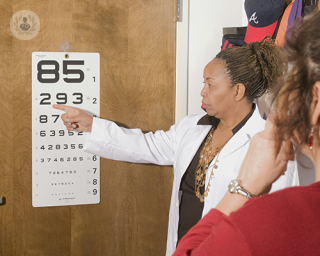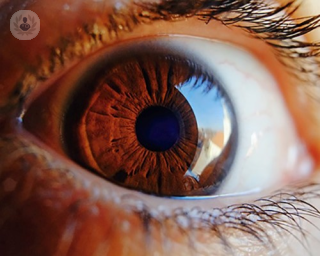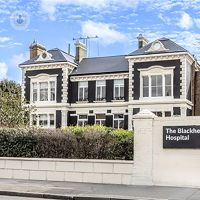What is retinal detachment?
Retinal detachment happens when the external retinal membrane (retinal pigment epithelium) separates from the internal retinal membrane (sensory retina).

There are three different types of retinal detachment:
- Rhegmatogenous: This is the most common retinal detachment. It happens when there is a tear in the retina that leads to fluid accumulation in the subretinal space.
- Tractional: This is the second most common type of retinal detachment. It happens when scar tissue grows on the retina and pulls it out of its normal position.
- Exudative (serous): This is the rarest type of retinal detachment. It happens when fluid collects under the retina (but there is no tear) due to inflammation or tumours.
Disorder prognosis
Prognosis after retinal detachment depends on the location and extent of detachment. In cases where the macula has no damage, prognosis is excellent.
It should be noted that successful retinal repair does not always completely restore vision. Some types of retinal detachment can’t be repaired.
What specialist should I see?
Retinal detachment is treated by an ophthalmologist.
What are the symptoms?
Having two or more of the following symptoms may be an indication retinal detachment:
- Seeing flashing lights.
- Blurry vision.
- Floaters that appear suddenly or increase suddenly.
- Shadow or blind spot in the field of vision.
Tests for retinal detachment
An ophthalmologist will examine the eyes and check the retina and pupil:
- Angiofluoresceinography: Checks the blood flow in the retina by using a camera and special dye.
- Tonometry: Measures eye pressure.
- Ophthalmoscopy: Examines that back of the eye, including the retina.
- Refraction test: Used to verify prescription glasses.
- Verification of chromatic vision.
- Visual acuity test: Determines the smallest letters that can be read on a standardised chart (Snellen chart).
- Slit lamp test: Checks the structures in the front of the eye.
- Eye ultrasound.
What causes it?
The main causes for retinal detachments are due to retinal tears or holes.
Other causes include:
- Ageing can cause retinal thinning and deterioration.
- Vitreous retraction: The vitreous is attached to the retina by many fibres. If it retracts, it may cause a tear or a hole. This is the most common cause of retinal detachment.
- Abnormal eye growth: Vitreous contraction may be caused due to myopia, inflammation or swelling, or eye trauma.
How can it be prevented?
It is crucial to have an ophthalmologic examination with pupillary dilation to be to check the retinal periphery.
If degenerative lesions that could cause detachment are found, laser treatment will be recommended.
Day-to-day tips:
- Wear protective glasses to prevent eye trauma.
- Diabetic patients should carefully monitor their blood sugar.
- See an ophthalmologist once a year.
- Be aware of new flashing light or floater symptoms.
Early diagnosis and treatment are essential for a good outcome.
What is the treatment?
In most cases treatment will involve surgery, for example in both rhegmatogenous and tractional retinal detachment. The former is the most common type of retinal detachment.
In cases of serious retinal detachment, the cause needs to be treated. This may be done by surgery, medications, or radiotherapy, amongst other treatments.
There are different types of surgery that can be used, depending on each case. Currently, the most commonly used is microsurgery through posterior vitrectomy via pars plana.
The aim of the treatment is to:
- Close the tear or rupture what has caused retinal detachment using laser or cryotherapy.
- Put the retina back in its place.
The procedure is normally done on an outpatient basis. Local anaesthetic and sedation are used.
11-13-2012 07-19-2023
Retinal detachment
Miss Rahila Zakir - Ophthalmology
Created on: 11-13-2012
Updated on: 07-19-2023
Edited by: Kate Forristal
What is retinal detachment?
Retinal detachment happens when the external retinal membrane (retinal pigment epithelium) separates from the internal retinal membrane (sensory retina).

There are three different types of retinal detachment:
- Rhegmatogenous: This is the most common retinal detachment. It happens when there is a tear in the retina that leads to fluid accumulation in the subretinal space.
- Tractional: This is the second most common type of retinal detachment. It happens when scar tissue grows on the retina and pulls it out of its normal position.
- Exudative (serous): This is the rarest type of retinal detachment. It happens when fluid collects under the retina (but there is no tear) due to inflammation or tumours.
Disorder prognosis
Prognosis after retinal detachment depends on the location and extent of detachment. In cases where the macula has no damage, prognosis is excellent.
It should be noted that successful retinal repair does not always completely restore vision. Some types of retinal detachment can’t be repaired.
What specialist should I see?
Retinal detachment is treated by an ophthalmologist.
What are the symptoms?
Having two or more of the following symptoms may be an indication retinal detachment:
- Seeing flashing lights.
- Blurry vision.
- Floaters that appear suddenly or increase suddenly.
- Shadow or blind spot in the field of vision.
Tests for retinal detachment
An ophthalmologist will examine the eyes and check the retina and pupil:
- Angiofluoresceinography: Checks the blood flow in the retina by using a camera and special dye.
- Tonometry: Measures eye pressure.
- Ophthalmoscopy: Examines that back of the eye, including the retina.
- Refraction test: Used to verify prescription glasses.
- Verification of chromatic vision.
- Visual acuity test: Determines the smallest letters that can be read on a standardised chart (Snellen chart).
- Slit lamp test: Checks the structures in the front of the eye.
- Eye ultrasound.
What causes it?
The main causes for retinal detachments are due to retinal tears or holes.
Other causes include:
- Ageing can cause retinal thinning and deterioration.
- Vitreous retraction: The vitreous is attached to the retina by many fibres. If it retracts, it may cause a tear or a hole. This is the most common cause of retinal detachment.
- Abnormal eye growth: Vitreous contraction may be caused due to myopia, inflammation or swelling, or eye trauma.
How can it be prevented?
It is crucial to have an ophthalmologic examination with pupillary dilation to be to check the retinal periphery.
If degenerative lesions that could cause detachment are found, laser treatment will be recommended.
Day-to-day tips:
- Wear protective glasses to prevent eye trauma.
- Diabetic patients should carefully monitor their blood sugar.
- See an ophthalmologist once a year.
- Be aware of new flashing light or floater symptoms.
Early diagnosis and treatment are essential for a good outcome.
What is the treatment?
In most cases treatment will involve surgery, for example in both rhegmatogenous and tractional retinal detachment. The former is the most common type of retinal detachment.
In cases of serious retinal detachment, the cause needs to be treated. This may be done by surgery, medications, or radiotherapy, amongst other treatments.
There are different types of surgery that can be used, depending on each case. Currently, the most commonly used is microsurgery through posterior vitrectomy via pars plana.
The aim of the treatment is to:
- Close the tear or rupture what has caused retinal detachment using laser or cryotherapy.
- Put the retina back in its place.
The procedure is normally done on an outpatient basis. Local anaesthetic and sedation are used.


Retinal detachment: an examination
By Mr Bhaskar Gupta
2025-01-20
Retinal detachment is a serious eye condition that occurs when the retina, the light-sensitive tissue at the back of the eye, becomes detached from its normal position, which can lead to a range of visual disturbances and, if left untreated, may result in permanent vision loss. Renowned consultant ophthalmologist and vitreoretinal specialist Mr Bhaskar Gupta examines the condition, including causes, diagnosis and what happens during retinal detachment surgery. See more


Retinal detachment: Early detection and treatment
By Mr Serafeim Antonakis
2025-01-20
Retinal detachment is a serious and vision-threatening eye condition that requires immediate medical attention. Here, Mr Serafeim Antonakis, renowned consultant ophthalmologist and vitreoretinal surgeon, provides a comprehensive overview of retinal detachment, including its signs and symptoms, causes, and treatment options. See more


Is seeing flashing lights in your eye a sign of retinal detachment?
By Miss Miriam Minihan
2025-01-20
Flashing lights in your eyesight look like flashes of lightening or if someone had taken a photograph with using the flash. Are you seeing them frequently and wondering if they are a cause for concern? Here, expert ophthalmologist Miss Miriam Minihan explains whether they are a sign of an underlying problem or not. See more


Saving sight: A guide to retinal detachment
By Dr Peter Cackett
2025-01-20
The human eye is an intricately designed organ, enabling us to perceive the world around us. One crucial component of vision is the retina, a thin layer of tissue located at the back of the eye that captures light and sends visual information to the brain. However, certain conditions, such as retinal detachment, can pose a significant threat to this vital sensory function. In his latest online article, Dr Peter Cackett gives us his insights into retinal detachment. He talks about the causes, symptoms, diagnosis, treatment, recovery and prognosis and preventive measures. See more
Experts in Retinal detachment
-
Mr Mahi Muqit
OphthalmologyExpert in:
- Eye floaters
- Epiretinal membrane
- Diabetic retinopathy
- Vitrectomy
- Macular hole
- Retinal detachment
-
Professor James Bainbridge
OphthalmologyExpert in:
- Cataracts
- Epiretinal membrane
- Macular hole
- Retinal detachment
- Eye floaters
- Retinal detachment surgery
-
Professor Tom Williamson
OphthalmologyExpert in:
- Retinal detachment
- Macular hole
- Epiretinal membrane
- Diabetic retinopathy
- Cataracts
- Vitrectomy
-
Mr Hadi Zambarakji
OphthalmologyExpert in:
- Retinal detachment
- Macular hole
- Epiretinal membrane
- Macular degeneration (AMD)
- Diabetic retinopathy
- Cataracts
-
Mr Roger Wong
OphthalmologyExpert in:
- Retina
- Diabetic retinopathy
- Retinal detachment
- Macular hole
- Epiretinal membrane
- Macular degeneration (AMD)
- See all

Optegra Yorkshire Eye Hospital
Optegra Yorkshire Eye Hospital
Optegra Eye Hospital Yorkshire, 937 Harrogate Road, Apperley Bridge, Bradford BD10 0RD
No existe teléfono en el centro.
By using the telephone number provided by TOP DOCTORS, you automatically agree to let us use your phone number for statistical and commercial purposes. For further information, read our Privacy Policy
Top Doctors

The Blackheath Hospital - part of Circle Health Group
The Blackheath Hospital - part of Circle Health Group
40-42 Lee Terrace, Blackheath, London SE3 9UD
No existe teléfono en el centro.
By using the telephone number provided by TOP DOCTORS, you automatically agree to let us use your phone number for statistical and commercial purposes. For further information, read our Privacy Policy
Top Doctors

The Alexandra Hospital - part of Circle Health Group
The Alexandra Hospital - part of Circle Health Group
Mill Ln, Cheadle, SK8 2PX
No existe teléfono en el centro.
By using the telephone number provided by TOP DOCTORS, you automatically agree to let us use your phone number for statistical and commercial purposes. For further information, read our Privacy Policy
Top Doctors
-
Optegra Yorkshire Eye Hospital
Optegra Eye Hospital Yorkshire, 937 Harrogate Road, Apperley Bridge, Bradford BD10 0RD, BradfordExpert in:
- Cataracts
- Laser eye surgery
- Refractive surgery
- ICL lens implants
- Lens replacement
-
The Blackheath Hospital - part of Circle Health Group
40-42 Lee Terrace, Blackheath, London SE3 9UD, East LondonExpert in:
- Vascular Surgery
- Cardiology
- Bariatric Surgery
- Colorectal surgery
- Endocrine Surgery
- General Surgery
-
The Alexandra Hospital - part of Circle Health Group
Mill Ln, Cheadle, SK8 2PX, CheadleExpert in:
- Hip
- Cardiology
- Shoulder and elbow
- Paediatrics
- Foot and ankle
- Knee
- See all
- Most viewed diseases, medical tests, and treatments
- Visual impairment
- Diabetic retinopathy
- Retina
- Visual stress (Meares-Irlen syndrome)
- Presbyopia
- Nystagmus
- Myopia
- Hyperopia (farsightedness)
- Eye examination
- Demodex








